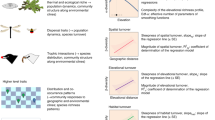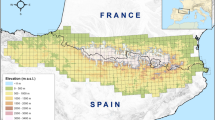Abstract
Until fairly recently, regional-scale ecological and evolutionarypatterns have tended to be ignored as conservation efforts have been concernedwith species and their habitats. Here we compare frequencies in the Egyptianflora of particular rank sizes (order, family and genus) with patterns ofspecies abundance (classified as very rare, rare, common, or very common) and anarray of life-history attributes. The angiosperm flora of Egypt is representedby 2446 taxa (2088 species), including taxa in 10 subclasses, 51 orders, 120families, and 742 genera. A high degree of monotypism was observed: four ordersare monotypic (each existing as single species), and have very rare overallabundances; 30 families are monotypic (17 of which are very rare or rare); and 354genera are monotypic (over 70% of which are very rare or rare). Fourteenfamilies (in particular the Resedaceae and Zygophyllaceae) have at leastone-fifth of their global species represented in the Egyptian flora. Introducedspecies in general, and tree, aquatic herb and liana life forms all are especially well represented among monotypic genera. Native taxa are highlyrepresented among rare and very rare abundance classes, while introduced taxadid not differ significantly in their abundance patterns, compared to overallflora values. Few large genera (>20 spp.) occur in the flora, with mostspecies concentrated in genera containing 8–19 species per genus.Similarly, few families were highly speciose. Annual and herbaceous species weresignificantly over-represented, mainly among large, speciose genera andfamilies. However, perennials, trees, shrubs, aquatic herbs, lianas and parasiticspecies were found mainly in families and genera having very few taxa.Life-history attributes may have important implications to speciation rates.Taxonomically based results, involving abundances and life-history attributes,are discussed in the context of biodiversity and conservation.
Similar content being viewed by others
References
Boulos L. 1995. Flora of Egypt: a Checklist. Al-Hadara Publishing, Cairo, Egypt.
Brewer A. and Williamson M. 1994. A new relationship for rarefaction. Biodiversity and Conservation 3: 373–379.
Buide M.L., Sanchez J.M. and Guitian J. 1998. Ecological characteristics of the flora of the Northwest Iberian Peninsula. Plant Ecology 135: 1–8.
Cadotte M.W. and Lovett-Doust J. 2001. Ecological and taxonomic differences between native and introduced plants of southwestern Ontario. Ecoscience 8: 230–238.
Cadotte M.W. and Lovett-Doust J. 2002. Ecological and taxonomic differences between rare and common plants of southwestern Ontario. Ecoscience (in press).
Clapham A.R., Tutin T.G. and Warburg E.F. 1962. Flora of the British Isles. Cambridge University Press, Cambridge, UK.
Crawley M.J., Harvey P.H. and Purvis A. 1996. Comparative ecology of the native and alien floras of the British Isles. Philosophical Transactions of the Royal Society of London 351: 1251-1259.
Cronquist A. 1988.The evolution and classification of flowering plants. 2nd edn. The New York Botanical Garden, Bronx, NY.
Crozier R.H. 1992. Genetic diversity and the agony of choice. Biological Conservation 61: 11–15.
Dodd M.E., Silvertown J. and Chase M.W. 1999. Phylogenetic analysis of trait evolution and species diversity variation among angiosperm families. Evolution 53: 732–744.
Edwards W. 1998. Rarity within taxonomic lineages and the use of taxa above the level of species. Ecography 21: 625–629.
Edwards A.L. and Weakley A.S. 2001. Population biology and management of rare plants in depression wetlands of the southeastern coastal plain, USA. Natural Areas Journal 21: 12–35.
El-Keblawy A., Cadotte M.W. and Lovett-Doust J. 2002. The many and the few: linking local and global phylogenetic diversity to ecological patterns in five middle eastern floras. Biological Journal of the Linnean Society (submitted).
Eriksson O. and Bremer B. 1991. Fruit characteristics, life forms, and species richness in the plant family Rubiaceae. American Naturalist 761: 751–761.
Eriksson O. and Bremer B. 1992. Pollination systems, dispersal modes, life forms, and diversifications rates in angiosperm families. Evolution 46: 258–266.
Faith D.P. 1992. Conservation evaluation and phylogenetic diversity. Biological Conservation 61: 1–10.
Fenner M., Lee W.G. and Wilson J.B. 1997. A comparative study of the distribution of genus size in twenty angiosperm floras. Biological Journal of the Linnean Society 62: 225–237.
Fitter A.H. and Peat H.J. 1994. The ecological flora database. Journal of Ecology 82: 415–425.
Grime J.P. 1974. Vegetation classification by reference to strategies. Nature 250: 26–31.
Grime J.P. 1984. The ecology of species, families, and communities of the contemporary British flora. New Phytologist 98: 15–33.
Harper J.L. 1977. Population Biology of Plants. Academic Press, New York.
Hodgson J.G. 1986. Commonness and rarity in plants with special reference to the Sheffield Flora. Part III: taxonomic and evolutionary aspects. Biological Conservation 36: 275–296.
Khedr A.A., Lovett-Doust J. and El-Keblawy A. 2002. Patterns of regional rarity and life history features in the Egyptian flora. In preparation.
Latham R.E. and Ricklefs R.E. 1993. Continental comparisons of temperate-zone tree species diversity. In: Ricklefs R.E. and Schluter D. (eds), Species Diversity: Historical and Geographical Perspectives. University of Chicago Press, Chicago, Illinois, pp. 294–314.
Legendre P. and Legendre L. 1998. Numerical Ecology. 2nd English edn. Elsevier, Amsterdam, the Netherlands.
Moritz C. 1994. Defining evolutionary significant units for conservation. Trends in Ecology and Evolution 9: 373–375.
Moss E.H. 1959. Flora of Alberta. University of Toronto Press, Toronto, Canada.
Newmaster S.G., Lehela A., Uhlog P.W.C., McMurray S. and Oldham M.J. 1998. Ontario plant list. Ministry of Natural Resources, Peterborough, Canada.
Purvis A., Agapow P.M., Gittleman J.L. and Mace G.M. 2000. Nonrandom extinction and the loss of evolutionary history. Science 288: 328–330.
Rejmanek M. and Randall S.M. 1994. Invasive alien plants of California: summary and comparison with other areas in North America. Madroño 41: 161–171.
Ricklefs R.E. and Renner S.S. 1994. Species richness within families of flowering plants. Evolution 48: 1619–1636.
Stebbins G.L. 1980. Rarity of plant species: a synthetic viewpoint. Rhodora 82: 77–86.
Täckholm V. 1974. Students' Flora of Egypt. 2nd edn. Cairo University, Cairo, Egypt.
Tiffney B.H. and Mazer J. 1995. Angiosperm growth habitat, dispersal and diversification reconsidered. Evolutionary Ecology 9: 93–117.
Turner I.M. 1997. A tropical flora summarized: a statistical analysis of the vascular plant diversity of Malaya. Flora 192: 157–163.
Vane-Wright R.I., Humphries C.J. and Williams P.H. 1991. What to protect? Systematics and the agony of choice. Biological Conservation 55: 235–254.
Walter K.S. and Gillett J.H. 1998. 1997 IUCN Red List of Threatened Plants. The World Conservation Union, Cambridge, UK.
Watson L. and Dallwitz M.J. 1992. The families of flowering plants: descriptions, illustrations, identification, and information retrieval. Version 14 December 2000. http://biodiversity.uno.edu/delta/.
Weber E.F. 1997. The alien flora of Europe: a taxonomic and biogeographic review. Journal of Vegetation Science 8: 565–572.
Williams P.H. and Gaston K.J. 1994. Measuring more of biodiversity: can higher-taxon richness predict wholesale species richness? Biological Conservation 67: 211–217.
Williams P.H. and Humphries C.J. 1994. Biodiversity, taxonomy relatedness and endemism in conservation. In: Forty P.L., Humphries C.J. and Vane-Wright R.I. (eds), Systematics and Conservation Evaluation. Clarendon Press, Oxford, UK, pp. 269–287.
Williams P.H., Humphries C.J. and Vane-Wright R.I. 1991. Measuring biodiversity: taxonomic relatedness for conservation priorities. Australian Systematic Botany 4: 665–679.
Author information
Authors and Affiliations
Rights and permissions
About this article
Cite this article
Khedr, AH., Cadotte, M.W., El-Keblawy, A. et al. Phylogenetic diversity and ecological features in the Egyptian flora. Biodiversity and Conservation 11, 1809–1824 (2002). https://doi.org/10.1023/A:1020312108530
Issue Date:
DOI: https://doi.org/10.1023/A:1020312108530




